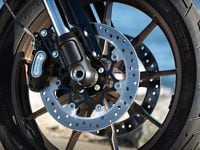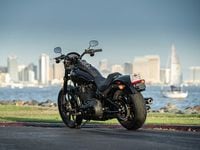Die-hard Dyna fans were disappointed when the original Low Rider S disappeared from the lineup a few years ago. Thankfully, The Motor Company has returned the Low Rider S to its lineup in the-redesigned-for-2017 Softail chassis paired with the mighty Milwaukee-Eight engine. With design language that gives a respectable nod to the Low Rider's '70s-era origin, can Harley-Davidson usher this beloved model into the future without alienating its loyal fans? We had the opportunity to take the new 2020 Low Rider S on a test ride to find out.
The biggest improvement to the Low Rider S over the standard Low Rider is the increase in displacement. The 2020 Low Rider S uses the Milwaukee-Eight 114ci engine (1,868cc) instead of the standard model's 107ci mill. The Milwaukee-Eight pumps out a claimed 119 pound-feet of torque at 3,000 rpm, providing a tad more torque at a lower rpm than the previous model. That torque comes in handy when twisting the throttle to get up to freeway speeds; merging with full speed traffic is effortless. While riding the back roads, the Low Rider S pulled through the twisties easily, thanks to that plethora of torque, without requiring a lot of shifting.
Related: 2020 Harley-Davidson Road Glide Limited First Look
New suspension components are part of the 2020 Low Rider S arsenal of performance bits, featuring an inverted 43mm Showa fork and a single preload-adjustable coil-over shock. That fork is set at a steeper, 28-degree rake, a major improvement over the 30-degree rake of the previous-generation Low Rider S and the standard 2020 Low Rider.
This translates to faster turn-in, making the bike much easier to flick through the corners. We had plenty of opportunity to test this faster turn-in during our test ride through the hills outside San Diego. The Low Rider S is a sporty bike, but what limits it is its lean angle. While its clearance of 30.1 degrees of lean angle is noticeably more than most other models in Harley-Davidson’s lineup, it could use more. During our test ride, I found the footpegs scraping earlier than I’d hoped when taking a more aggressive lean into a corner. The front end suspension felt compliant enough to keep the bike well poised during aggressive riding and over bumps and ruts, but the rear end felt stiff. Despite preload adjustability, the shock’s spring proved to be heavier than my weight could properly compress, though I would imagine most average-sized Americans (around 180–200 pounds) won’t find the rear suspension as stiff as I found it.
Aggressiveness is the name of the game with the new Low Rider S, and it shows in the bike’s ergonomics. The 1-inch dirt bike-style bars with the 4-inch riser creates a higher handlebar position. This contributes to the more aggressive rider triangle on the new Low Rider S, in addition to the mid sets, which keep the riders knees bent and feet high off the ground.
The downside to this setup is that the reach from the seat to the handlebars in conjunction with the reach from the seat to the footpegs folded my knees enough to put a bend in my hip flexor that was uncomfortable about halfway through the day. And with the 114ci engine to straddle, just standing up out of the saddle at a stoplight wasn’t enough to stretch my joints to alleviate the mild cramping. Thankfully Harley-Davidson offers different saddle options in its parts and accessories catalog. These seat options increase the height or push the rider forward and closer to the bars. It’s good to know that Harley-Davidson takes rider comfort seriously.
As it was, I felt stretched out reaching up to the handlebars, causing my shoulders to join my hip flexors in aching halfway through the day’s ride. Thankfully those handlebars and risers can be swapped out or repositioned for a more custom ergonomic setup.
The brakes on the 2020 Low Rider S have been upgraded from the previous model. Sporting Nissin dual front four-piston calipers gripping 300mm discs, the new LRS provides twice the stopping power of the standard model up front (which only has a single disc). The bike is slowed down at the rear by a single two-piston caliper on a 292mm disc. The Low Rider S comes standard with ABS, which provides extra assurance in emergency braking situations.
Taking inspiration from the West Coast custom V-twin scene, The Motor Company channeled an aggressive look into the new Low Rider S. Nearly all the previously bright components have been blacked out, leaving barely a shred of chrome. From the blacked-out Softail frame to the fork legs to the headers and silencers to the airbox cover, everything has been given a sinister look. Choose the gloss black tank color with matching mini headlight fairing, and the only thing on the bike that isn’t black are the 19-inch front and 16-inch rear cast-aluminum wheels finished in dark bronze. Add an LED headlight and the new Low Rider S has a menacing face and stance.
With the gauges mounted on the tank instead of on the handlebar, Harley-Davidson continued a specific style for this cruiser. The downside to this is having to take my eyes off the road to see what speed I’m going. I can’t even see the gauges in my peripheral vision when focusing on the next corner. With the mini headlight fairing, there is clearly enough room for the gauges to be mounted within the rider’s peripheral vision, though that leads to the routing of more electricals from the top triple clamp area. It’s a trade-off to keep those gauges mounted on the tank, though it’s subjective whether that’s worthwhile or not.
For most riders, the new Low Rider S is an improvement over the Dyna-based model. The Softail chassis provides lighter and stiffer handling, while the counterbalancers within the engine keep the hard-mounted V-twin’s vibrations from numbing your extremities. The steeper rake helps the LRS handle twisties in a much more aggressive manner, and the look is consistent with the West Coast V-twin scene. You may have shed a tear or two when Dyna was erased from Harley’s lineup, but the new Low Rider S is sure to ease that broken heart. In fact, you might just forget your Dyna altogether.
Helmet: Shoei GT-Air II Jacket: Alpinestars Stella Dyno v2 Gloves: Racer Gloves Short Sport Ladies Pant: Alpinestars Daisy Jeans Boots: Alpinestars Stella Kerry Boots




























/cloudfront-us-east-1.images.arcpublishing.com/octane/QSTCM6AVEZA5JJBUXNIQ3DSOF4.jpg)
/cloudfront-us-east-1.images.arcpublishing.com/octane/U4I7G625B5DMLF2DVIJDFZVV6M.jpg)
/cloudfront-us-east-1.images.arcpublishing.com/octane/B6XD6LS6IVCQPIU6HXDJSM3FHY.jpg)
/cloudfront-us-east-1.images.arcpublishing.com/octane/ICL63FEDDRDTTMINYICCEYGMDA.jpg)
/cloudfront-us-east-1.images.arcpublishing.com/octane/FCGZHQXRBZFLBAPC5SDIQLVF4I.jpg)
/cloudfront-us-east-1.images.arcpublishing.com/octane/WNOB6LDOIFFHJKPSVIWDYUGOPM.jpg)

/cloudfront-us-east-1.images.arcpublishing.com/octane/X33NU3E525ECRHXLNUJN2FTRKI.jpg)
/cloudfront-us-east-1.images.arcpublishing.com/octane/6KKT5NNL2JAVBOXMZYS5ZO76YA.jpg)
/cloudfront-us-east-1.images.arcpublishing.com/octane/J5RKG5O455GMPGQRF2OG6LRT7A.jpg)
/cloudfront-us-east-1.images.arcpublishing.com/octane/GX2CIZKQVRH2TATDM26KFG2DAE.jpg)
/cloudfront-us-east-1.images.arcpublishing.com/octane/ZWIDYSAKQZHD5BHREMQILXJCGM.jpg)
/cloudfront-us-east-1.images.arcpublishing.com/octane/CYUHJZCTSJCH3MRAQEIKXK7SCQ.jpg)
/cloudfront-us-east-1.images.arcpublishing.com/octane/LKOFINY56FCXJCANJ5M7ZDQUBY.jpg)
/cloudfront-us-east-1.images.arcpublishing.com/octane/4NBPDACMWJH63JQYJVK3QRBDZI.jpg)
/cloudfront-us-east-1.images.arcpublishing.com/octane/KKHQHRR3FJGX7H2IPU6RALMWG4.jpg)

/cloudfront-us-east-1.images.arcpublishing.com/octane/5IOFS5JAE5FOXMNA23ZRAVVYUU.jpg)
/cloudfront-us-east-1.images.arcpublishing.com/octane/CGXQ3O2VVJF7PGTYR3QICTLDLM.jpg)

/cloudfront-us-east-1.images.arcpublishing.com/octane/OQVCJOABCFC5NBEF2KIGRCV3XA.jpg)
/cloudfront-us-east-1.images.arcpublishing.com/octane/OPVQ7R4EFNCLRDPSQT4FBZCS2A.jpg)
/cloudfront-us-east-1.images.arcpublishing.com/octane/YBPFZBTAS5FJJBKOWC57QGEFDM.jpg)
/cloudfront-us-east-1.images.arcpublishing.com/octane/W5DVCJVUQVHZTN2DNYLI2UYW5U.jpg)